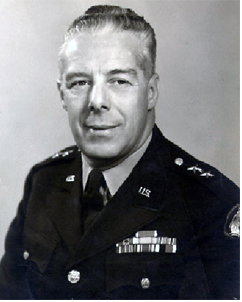Major General
Waldo E. Laidlaw
 Waldo E. Laidlaw graduated
from the United States Military Academy in 1926 with a commission in the infantry. He was detailed to he
Ordnance Corps in 1931 after serving in the 31st Infantry Regiment in the Philippines and transferred to the
Ordnance Department in 1935.
Waldo E. Laidlaw graduated
from the United States Military Academy in 1926 with a commission in the infantry. He was detailed to he
Ordnance Corps in 1931 after serving in the 31st Infantry Regiment in the Philippines and transferred to the
Ordnance Department in 1935.
He graduated from the Massachusetts Institute of Technology (MIT) in 1932 with a degree in mechanical engineering and completed the Ordnance School in 1933 enroute to his first Ordnance assignment at Picatinny Arsenal.
In Picatinny's Time Fuse Division, he put his MIT education in time and motion studies to work. Much to his credit, he not only increased time fuse production from 2,400 to 4,200 a day but also significantly reduced the cost per fuse. Impressed with Laidlaw's enthusiasm, the arsenal commander selected him as the Assistant to the Chief of the Ammunition Research and Development Branch.
From 1937 to 1939, he commanded the 27th Ordnance Maintenance Company, First Cavalry Division, Ft. Bliss, Texas. Prior to the US entry in World War II, he served in the Office of the Chief of Ordnance and was responsible for preparing tables of organization, technical manuals, and supply parts lists for the growing number of units and types of equipment in the Army's force structure.
In July 1942, he was assigned as the Ordnance Officer at the New York Port of Embarkation (NYPOE), where he coordinated the shipment of more than 150,000 items of Ordnance equipment and supplies through three aerial and seven seaports. At the conclusion of the war in Europe, he transferred to the San Francisco Port of Embarkation and put his experience to work in shipping the supplies and equipment needed for the impending invasion of Japan.
With the end of the war in the Pacific, he was transferred to Germany and served as Assistant Chief of Staff for Logistics for the Continental Base Section of the European Command from 1946 to 1947. Next he was assigned as Fourth Army Ordnance Officer at Ft. Sam Houston, Texas and then as Commandant of the Ordnance School at Aberdeen Proving Ground, where he directed the expansion of the training base to meet the needs of the Korean War.
In 1952, he took command of the Ordnance Ammunition Center which was comprised of 23 ammunition plants, most of which had to be reactivated and ramped up to produce the $270 million worth of ammunition needed each month during the Korean War period.
Following a tour as the Chief of Staff of Army Forces, Caribbean Command, he culminated his career as Commander, White Sands Missile Range where he directed a major expansion to accommodate the military's growing missile development program.
MG Laidlaw retired in 1960 after 34 years of distinguished active service. He died in October 1987.